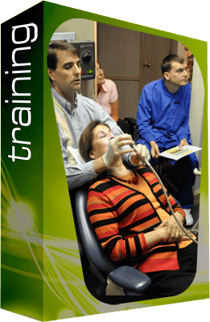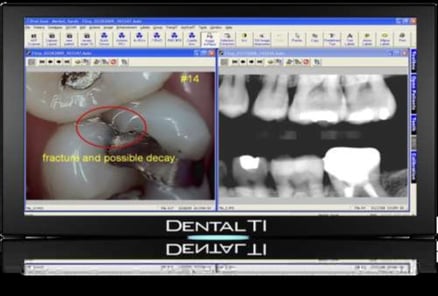Many Dental offices consider themselves to be “digital” offices. They have incorporated computers at
the front desk and in the treatment rooms and have software that manages their practice
and electronic images – both camera and radiographic. The dentists with such offices have invested
time, money, and often times have endured a good amount of frustration to get there. In addition,
many high- tech offices are under utilizing their systems and only deriving a fraction of the benefit that
could be garnered with the correct “vision of utilization” and “proper training” to achieve it.
If over a period of time an office spends roughly five dollars per patient to be “high-tech”, the return on
investment should yield more than five dollars per patient to be considered a sound investment. What
is the difference between practices that generate $5 per patient and barely cover their costs and those
that see $20+ revenue gains per patient and consider technology a “game changer” for their practice?
The difference can be summed up in two words “Vision” and” Execution”.

Turning Vision and Execution into Profit
The offices that are seeing the highest returns on investment from their technology had a vision
of increased efficiency and effectiveness in mind when they embarked on the path to becoming hightech.That general vision translated to a more specific vision of what being “high- tech” would mean to their day to day operations. The “flow” of information was discussed with the staff so they understood their roles in implementing the technology to make it a success. Also, the specific efficiencies gained were conveyed to the staff in relation to their daily duties (e.g. “Mary, when the patient comes to the front desk you will ‘always’ access their work to be scheduled through the patient chart and treatment plan. The entry in the patient treatment plan can be ‘right clicked’ and scheduled without having to reenter it.”) Mary immediately sees the benefit of having the information readily at hand and the elimination of her typing it in from handwritten notes. She can focus on the patient and make sure that the entire patient experience was pleasant and understood.
Patient understanding is probably the single most profitable use of technology because it
translates directly to scheduled appointments. Offices that are profitable with technology use their
intraoral cameras and digital x-ray to create a clear visual presentation of the patient’s oral health. The
following “process” of utilization illustrates the time savings to the dentist and the stress relief that
comes from making visual communication always be a part of the exam.
1. Intraoral Camera images and x-rays are always displayed when the dentist enters the
room. The dentist always has a clear, diagnostic image and x-ray one click away when he
or she is conveying the need for treatment to the patient.
2. The hygienist is orchestrating the exam flow by controlling two screens: one with x-rays
and camera images and one with the patients’ electronic chart.
3. Treatment plans are entered as they are dictated by the dentist.
4. When the patient leaves the room, all of the information that was entered chair side is
available at any other terminal in the office. At the front desk or in a consult room the
person scheduling treatment can review images associated with areas that need treatment
and can print or e-mail those images to the patient to solidify their commitment to keeping
the scheduled appointment.
In the end, offices that maximize their profit with technology use it for what it was intended:
improved efficiency in dealing with information and increased effectiveness in communicating with the
patient.

Training is the Missing Link
Even if you did not have an overall vision of how to use your technology when you made the leap into
the digital world, it is never too late to develop a vision and put it in place. Chances are your staff
has struggled with certain elements of your system since it was deployed. Has your office
consistently experienced any of the following?
1. Digital x-rays that are not of diagnostic quality or great variances in quality from one
exposure to the next.
2. Intraoral camera images are not being taken routinely; or, when they are taken they are
not clearly identified and are cloudy looking or out of focus.
3. Information is taken from hand written notes and entered into the Practice Management
software at the front desk rather than chair side.
The key to getting more from your investment in technology is coupling a required electronic “flow” of
information with training that is solely focused on helping your office achieve the “flow.”The following
action plan will help you achieve the correct “flow” in your practice:
1. Record your existing patient experience step by step and determining how you
are currently utilizing your hardware and software.
2. Contrast your existing “flow” with an ideal “flow”. An ideal flow captures all
information electronically and totally eliminates all redundant data entry. Note where the
holes are in your current flow.
3. Patient imaging – intraoral and radiographs – are diagnostic and complete. Compare
your existing full patient exam with Dental TI’s full patient exam. Modify your
existing protocol to create an efficient and complete examination. Many image
management programs allow for user created templates. Check with your software vendor
to see if a template is available for organizing intraoral camera images when the images
are taken in a particular order.

Dental TI’s “Complete Patient Exam”
The dentist should never have to discuss treatment without a clear image of the tooth on the screen
and an accompanying radiograph. When the patient gets treatment the camera should be used
to clearly demonstrate and record the procedure and the end result to build value for future treatment.
The office should seek professional training for optimization of their software and hardware –
intraoral cameras and digital x-ray. Additionally, the vision should be clear and the day to day path
should be clearly defined before a trainer is employed. When the path is shared with the trainer, the
training can be structured to ensure a process is in place that maximizes your technology while
making the patient experience more personal. If you have made the investment in technology and feel
that it is more of an expense than revenue generator, perhaps it is time to visualize successful
implementation and get the staff trained to make it happen!
-David Hanning, CEO Dental TI




Leave Comment